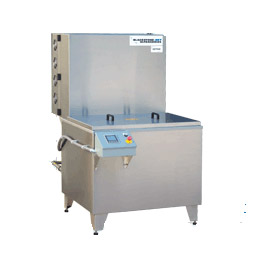
Cleaning Technologies Group (CTG) offers a wide range of Ransohoff and Blackstone-NEY Ultrasonics cleaning solutions that are well suited to meeting the requirements of aviation and aerospace parts cleaning. Our cleaning systems are designed to provide thorough, but gentle cleaning to remove all contaminants from part contours and surfaces. Our parts cleaning equipment assures aviation and aerospace parts manufacturers of the highest quality results to meet the toughest challenges and most rigorous standards.
CTG Aviation & Aerospace Parts Cleaning Advantages
- Standard systems include separate or a combination of immersion, spray, ultrasonic, and flush
- Custom systems specifically designed for tough applications include Hi-Pressure, immersion, and ultrasonics
- Size appropriate options for reducing cost and improving throughput
- In-house lab for evaluating material capability and cleanliness
- Ability to identify and develop the most effective parts cleaning solutions
Ransohoff and Blackstone-NEY Aviation & Aerospace Proven Successes
Two examples of successful aviation and aerospace parts cleaning installations include a jet engine turbine solution and a used aircraft brake component solution. Blasting media and coolant slurry presented difficult challenges for the jet engine turbine producer. A Leanjet RB-2 Ultrasonic cell washer was selected to provide a washing and rinsing process of agitation, spray impingement, hydraulic purging through immersion and rotation, ultrasonics, and heated blow-off drying. An AgiSonic was selected to handle the grease and dirt from the aircraft brake component operation, powered by agitating lift and ultrasonics. For more details on these applications, download the case studies below.
Aerospace Passivation

The process of passivation promotes the formation of a thin layer of oxidation on the part surface which acts as a protective coating. This process occurs naturally in stainless steels and titanium alloys, but the surface purity can be enhanced by treating the materials in a controlled citric or nitric acid process. This film is about 100,000 times thinner than a human hair and though the layer can be removed through abrasion, it is extremely durable. The chemical action of passivation, will actually penetrate 0.00508mm deep into the surface of the material.
The ultrasonic cleaning and passivation systems provided by Blackstone-NEY Ultrasonics utilize industry compliant materials and fabrication techniques to ensure that they are process capable of providing repeatable and reliable results. State of the art design techniques include redundant control measures, process traceability through data collection/access software, sanitary plumbing and filtration loops, and controlled environments.
Combining ultrasonic cleaning with pickling, passivation, rinsing, neutralization, and drying and other processing steps in a unitized cleaning console helps assure process integrity. The addition of an automated, robotic transfer system provides process consistency and significantly reduces the labor required for part processing Blackstone-NEY Ultrasonics has extensive experience providing cleaning solutions ranging from the removal of gross contaminants up to precision cleaning at the sub-micron level.
We have provided passivation systems to the aerospace industry around the globe, utilizing our proprietary Blackstone-NEY Ultrasonic technology as the core component of every system. Our knowledgeable sales and applications teams look to support customers in the early stages of process evaluation to ensure that the correct process and equipment is specified from the beginning of your project.
Aerospace MRO
Aerospace industry standards apply not only to new components but to the maintenance, repair, and refurbishing of parts used in aerospace industry applications. The Blackstone-NEY AgiSonic ultrasonic cleaning machine is a robust system designed to handle the challenges of aerospace parts MRO cleaning needs, including:
- Preventive Maintenance - schedule-based maintenance, calendar-based maintenance, and usage-based maintenance. Each type would require different levels of technology and expertise.
- Corrective Maintenance - issues that typically arise from equipment breakdowns or routine inspections.
- Predictive Maintenance - maintenance activities are carried out when specific conditions are met according to tools and sensors installed to monitor the status of a particular asset.
Applications:
- Turbine Blades
- Rotating Engine Components (Download Case Study)
- Landing Gear
- Helicopter Transmission Components
- Airfoils
- Aircraft Brakes (Download Case Study)
- Exhaust Shrouds







 English
English Spanish
Spanish Chinese
Chinese Canada
Canada Mexico
Mexico United Kingdom
United Kingdom




